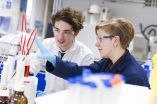(Press-News.org) BOSTON, Aug.19, 2015 -- Cross contamination in commercial processing facilities that prepare spinach and other leafy greens for the market can make people sick. But researchers are reporting a new, easy-to-implement method that could eliminate or reduce such incidences.
The scientists will present their work at the 250th National Meeting & Exposition of the American Chemical Society (ACS), the world's largest scientific society. The meeting features more than 9,000 reports on new advances in science and other topics. It is being held here through Thursday.
Each year 48 million Americans get sick; 128,000 are hospitalized; and 3,000 die of food poisoning, according to the U.S. Centers for Disease Control and Prevention. And spinach or other leafy salad greens were responsible for 18 food-poisoning outbreaks over the last decade.
Greens are washed by commercial processes before they head to the grocery store. But these methods, which can include water and bleach rinses or irradiation, are not completely effective, says Nichola Kinsinger, Ph.D. She says scientists have estimated that 99 percent of food-borne illnesses from leafy greens can be traced back to disinfection issues. As a result, they have searched for and developed a different approach to attacking the bacteria, most notably E. coli, which is the cause of many outbreaks.
"Despite current disinfection rinsing, bacteria are surviving on the leaf and causing cross contamination, resulting in the numerous outbreaks we hear about in the media," Kinsinger says. She is a postdoc in the lab of Sharon Walker, Ph.D., at the University of California, Riverside. "Pathogens can come from irrigation waters or from water used during processing, and they can adhere to spinach leaves. If these bacteria are not all killed in the disinfection process, they can continue to live, grow, spread and contaminate other surfaces within the facility and other leaves."
Using a parallel-plate flow chamber system that Walker developed, the researchers tested the real-time attachment and detachment of bacteria to the outer layer of spinach leaves. At low bleach concentrations, the bacteria fell off the leaves, but remained alive. At the higher concentrations used commercially, however, all of the bacteria were killed. "This result was perplexing," Walker says. "Our experiments were telling us that commercial bleach rinses should be much more effective than they are. But then we studied the leaf itself in more detail."
A spinach leaf is not perfectly smooth, she notes. So, the team modeled how the bleach would move across the surface of a spinach leaf, taking its bumps and grooves into account. Surprisingly, the model revealed that the concentrations of bleach on leaves may not be consistent.
"We found that because of the topology of the spinach leaf, nearly 15 percent of the surface may 'see' a bleach concentration that is 1,000-times less than that of the rinse solution," Kinsinger says. In some cases, that translated to a 90 percent bacterial survival in their tests -- and a high risk for cross contamination.
To reduce that risk, the researchers are optimizing an inexpensive titanium dioxide (TiO2) photocatalyst that companies could add to the rinse water or use to coat equipment surfaces that come into contact with the leaves as they are processed. When TiO2 absorbs light, it produces a strong oxidant that kills bacteria.
The scientists now plan to conduct more studies on the photocatalyst, and they will look at a broader range of foods, engineered surfaces and pathogens.
INFORMATION:
The researchers acknowledge funding from the USDA National Institute for Food and Agriculture under the Agriculture and Food Research Initiative.
The American Chemical Society is a nonprofit organization chartered by the U.S. Congress. With more than 158,000 members, ACS is the world's largest scientific society and a global leader in providing access to chemistry-related research through its multiple databases, peer-reviewed journals and scientific conferences. Its main offices are in Washington, D.C., and Columbus, Ohio.
To automatically receive news releases from the American Chemical Society, contact newsroom@acs.org.
Note to journalists: Please report that this research was presented at a meeting of the American Chemical Society.
Follow us: Twitter | Facebook
Title
Is our salad safe? Efficacy of disinfection techniques to decontaminate spinach leaves and reduce cross-contamination
Abstract
Each year bacterial contamination impacts consumers, causing food related bacterial outbreaks endangering countless lives and often resulting in death. The Center for Disease Control estimates that 1 in 6 people become ill annually and 3,000 peopled die from foodborne diseases. Cross-contamination from 0.1% of produce accounts for 99% of illnesses due to ineffective disinfection rinses used post-harvest. There have been several recent outbreaks of Escherichia coli O157:H7in leafy green products such as prepackage salad and baby spinach. The attachment and detachment kinetics of E. coli from both whole baby spinach leaves and isolated epicuticle layers of the spinach is investigated using a parallel plate flow chamber. Specifically, mass transfer rate coefficients for both attachment and detachment from the leaves or leaf epicuticle layers are being determined as a function of a range of relevant environmental parameters. The impact of water chemistry and common disinfection rinses on the removal and inactivation of E. coli on spinach leaves is also investigated. The spinach leaf texture has been incorporated within a COMSOL model to evaluate disinfectant concentration gradients that may limit rinsing efficacy and result in dangerous foodborne outbreaks. Optimization of TiO2 photocatalyst is evaluated as a supplemental and alternative technology to reduce cross-contamination during produce rinsing. This project is at the food safety-water nexus, where understanding the contribution of water chemistry will ensure proper food safety through irrigation, harvesting and processing.
BOSTON, Aug. 19, 2015 -- Alcoholism inflicts a heavy physical, emotional and financial toll on individuals and society. Now new discoveries and promising animal studies are offering a glimmer of hope that a new class of drugs could treat the disease without many of the unwanted side effects caused by current therapies.
Researchers are presenting the results of their work today at the 250th National Meeting & Exposition of the American Chemical Society (ACS), the world's largest scientific society. The meeting features more than 9,000 presentations on a wide range of science ...
University of Tokyo researchers discovered an increase in a helium isotope during a ten-year period before the 2014 Mount Ontake eruption in central Japan. The finding suggests that this helium isotope anomaly is related to activation of the volcano's magma system and could be a valuable marker for long-term risk mitigation concerning volcanic eruption.
Small quantities of the isotope helium-3 are present in the mantle, while helium-4 is produced in the crust and mantle by radioactive decay. A higher ratio of helium-3 to helium-4 therefore indicates that a sample of helium ...
Seven million women a year in the developing world are treated in healthcare facilities for complications following unsafe abortion, finds a study published today (19 August) in BJOG: An International Journal of Obstetrics & Gynaecology (BJOG).
Every day, approximately 800 women die from preventable causes related to pregnancy and childbirth. Unsafe abortion accounts for 8 - 15% of maternal deaths and remains one of the leading causes of maternal mortality worldwide.[1] However, these figures do not take into account the number of women who are surviving but need hospital ...
New research from the University of East Anglia could one day help build computers from DNA.
Scientists have found a way to 'switch' the structure of DNA using copper salts and EDTA (Ethylenediaminetetraacetic acid) - an agent commonly found in shampoo and other household products.
It was previously known that the structure of a piece of DNA could be changed using acid, which causes it to fold up into what is known as an 'i-motif'.
But new research published today in the journal Chemical Communications reveals that the structure can be switched a second time into ...
A nine-gene molecular prognostic index (MPI) for patients with early-stage non-small cell lung cancer (NSCLC) was able to provide accurate survival stratification and could potentially inform the use of adjuvant therapy in patients struggling with the disease, according to a study published August 18 in the JNCI: Journal of the National Cancer Institute.
Non-small cell lung cancer (NSCLC) accounts for roughly 85% of all lung cancers, additionally; lung cancer is the leading cause of cancer death through out the world. While gene expression profiles have been shown to ...
Alexandria, VA - The American Geosciences Institute's Center for Geoscience and Society is pleased to release two reports concerning geosciences education in the United States. The reports were developed in response to the need for comprehensive monitoring of the U.S. educational system in terms of the instruction of geoscience content and participation in geoscience-related learning experiences. The reports are based on data pertaining to science education collected from all 50 states and the District of Columbia.
The "Report on the Status of K-5 Geosciences Education ...
COLUMBUS, Ohio - Scientists at The Ohio State University have developed a nearly complete human brain in a dish that equals the brain maturity of a five-week-old fetus.
The brain organoid, engineered from adult human skin cells, is the most complete human brain model yet developed, said Rene Anand, professor of biological chemistry and pharmacology at Ohio State.
The lab-grown brain, about the size of a pencil eraser, has an identifiable structure and contains 99 percent of the genes present in the human fetal brain. Such a system will enable ethical and more rapid ...
Baltimore, August 18, 2015--Contact precautions are recommended by the Centers for Disease Control and Prevention (CDC) for all patients known to be infected with or carrying multidrug-resistant organisms (MDROs) such as methicillin-resistant Staphylococcus aureus (MRSA) and vancomycin-resistant Enterococcus (VRE). Yet, the use of contact precautions--which require a patient to be isolated in a single hospital room and health care providers to wear a gown and gloves when caring for patients--is widely debated in the medical community.
To help inform best practices, a ...
This news release is available in French. The atmosphere is so unstable that a butterfly flapping its wings can, famously, change the course of weather patterns. The celebrated "butterfly effect" also means that the reliability of weather forecasts drops sharply beyond 10 days.
Beyond this, there are strong fluctuations in temperature, with increases tending to be followed by decreases, and vice-versa. The same pattern holds true over months, years and decades. "This natural tendency to return to a basic state is an expression of the atmosphere's memory that is so ...
CORAL GABLES, Fla. (August 18, 2015) - The Krüppel-like factor and specificity protein (KLF/SP) genes are found across many species, ranging from single cell organisms to humans. This gene family has been conserved during evolution, because it plays a vital role in regulating the expression of other genes. Understanding the evolutionary history of the KLF/SP gene family may shed light on major events in animal evolution and perhaps help discern some of the molecular mechanisms associated with certain human diseases, including many cancers.
By closely examining the ...

